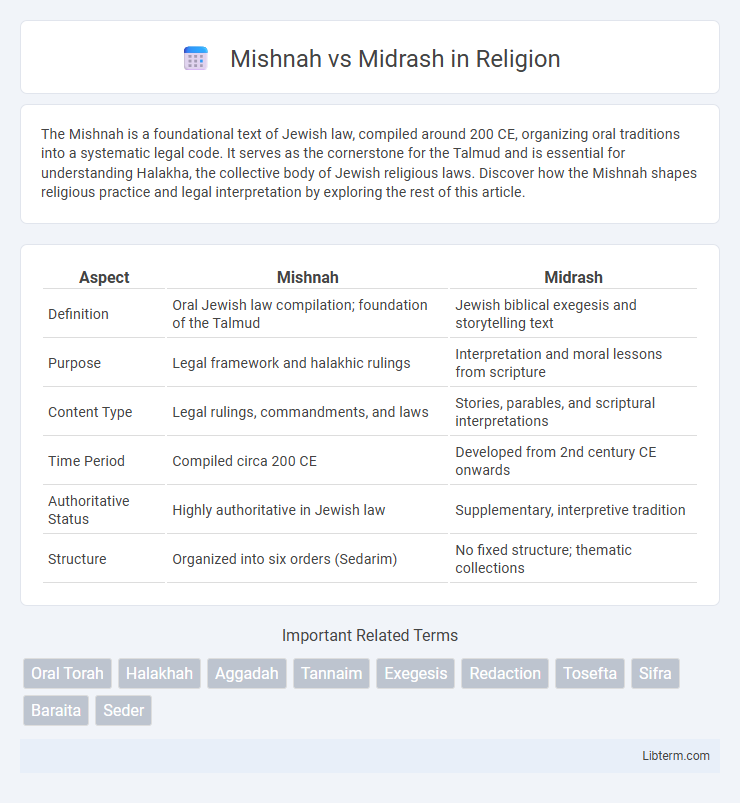The Mishnah is a foundational text of Jewish law, compiled around 200 CE, organizing oral traditions into a systematic legal code. It serves as the cornerstone for the Talmud and is essential for understanding Halakha, the collective body of Jewish religious laws. Discover how the Mishnah shapes religious practice and legal interpretation by exploring the rest of this article.
Table of Comparison
| Aspect | Mishnah | Midrash |
|---|---|---|
| Definition | Oral Jewish law compilation; foundation of the Talmud | Jewish biblical exegesis and storytelling text |
| Purpose | Legal framework and halakhic rulings | Interpretation and moral lessons from scripture |
| Content Type | Legal rulings, commandments, and laws | Stories, parables, and scriptural interpretations |
| Time Period | Compiled circa 200 CE | Developed from 2nd century CE onwards |
| Authoritative Status | Highly authoritative in Jewish law | Supplementary, interpretive tradition |
| Structure | Organized into six orders (Sedarim) | No fixed structure; thematic collections |
Introduction to Mishnah and Midrash
The Mishnah, compiled around 200 CE by Rabbi Judah the Prince, serves as the foundational codification of Jewish oral law, systematically organizing legal principles into six orders. Midrash encompasses a diverse collection of rabbinic commentaries and interpretations of Hebrew Scriptures, aiming to explore biblical narratives and laws through homiletic and exegetical methods. While the Mishnah focuses on legal rulings and halachic debates, Midrash enriches biblical texts with ethical lessons and expanded narratives.
Historical Development and Origins
The Mishnah, compiled around 200 CE by Rabbi Judah the Prince, represents the earliest systematic codification of Oral Torah, serving as the foundation for Rabbinic Judaism's legal framework. Midrash, emerging roughly between the 2nd and 5th centuries CE, developed as an exegetical method and body of literature aimed at interpreting and expanding upon biblical texts through homiletic and narrative techniques. Both texts arose during the post-Second Temple period, reflecting evolving Jewish responses to legal, theological, and cultural challenges under Roman rule.
Definitions and Core Purposes
The Mishnah is a foundational Jewish text composed of concise legal rulings and teachings that codify oral laws, serving as the primary source for halakhic (Jewish legal) discussions. Midrash encompasses a broad collection of interpretative narratives and exegetical commentaries that explore biblical texts, aiming to explain, expand, and find ethical or theological meanings within scripture. While the Mishnah emphasizes legal structure and practical application of Jewish law, Midrash offers creative and homiletic insights that illuminate biblical stories and commandments.
Structure and Composition Differences
The Mishnah is a codified legal text organized into six orders (Sedarim), each containing tractates (Masechtot) that systematically present Jewish oral laws and traditions in concise, structured language. In contrast, the Midrash consists of expansive rabbinic commentaries and homiletic interpretations, often arranged thematically or by scriptural verse, emphasizing narrative and ethical teachings rather than strict legal codification. While the Mishnah prioritizes precise legal rulings within a formal framework, the Midrash embraces a more fluid and discursive composition, blending halakhic and aggadic material.
Key Themes and Topics Covered
The Mishnah primarily offers a legal framework addressing Jewish law (Halakha), rituals, ethics, and civil matters, serving as the foundational text for the Oral Torah. The Midrash explores biblical narratives through homiletic interpretation, emphasizing moral lessons, theological insights, and elaborations on scripture to fill in narrative gaps. Together, these texts complement each other by combining legal codification with imaginative exegetical storytelling in Jewish tradition.
Role in Rabbinic Literature
The Mishnah serves as the foundational legal code of Rabbinic literature, systematically compiling Jewish oral laws and halakhic rulings. Midrash complements this by providing exegetical narratives and homiletic interpretations that elucidate biblical texts and ethical teachings. Together, they form a dual framework that balances formal legal discourse with rich theological and moral insights in Jewish tradition.
Methods of Interpretation and Analysis
The Mishnah employs a legalistic and systematic method of interpretation, focusing on codifying Jewish oral laws through precise categorization and concise rulings. Midrash utilizes a more expansive and narrative-driven approach, often exploring biblical texts through allegory, homiletics, and creative storytelling to reveal deeper ethical and theological meanings. While the Mishnah emphasizes halakhic clarity and practical application, Midrash prioritizes exegetical exploration and moral insights, reflecting distinct methods of textual analysis within Rabbinic tradition.
Influence on Jewish Law and Tradition
The Mishnah serves as the foundational legal codex of Jewish oral law, codifying halakhic rulings that shape everyday religious practice and judicial decisions. Midrash complements this by providing exegetical narratives and ethical teachings that deepen interpretive understanding, enriching the spiritual and moral dimensions of Jewish tradition. Together, the Mishnah and Midrash form a dynamic framework, where legal precision intersects with narrative insight, profoundly influencing Jewish law and cultural continuity.
Prominent Examples of Mishnah and Midrash
The Mishnah prominently features legal tractates such as Berakhot, focusing on blessings and prayers, and Sanhedrin, which details judicial procedures and criminal law. In contrast, Midrash includes collections like Midrash Rabbah, which offers extensive biblical commentary and narrative expansions on the Torah and the Five Megillot. While the Mishnah serves as the foundational codex of Jewish oral law compiled around 200 CE, Midrash provides interpretative stories and homiletic teachings that enrich scriptural understanding.
Lasting Impact and Contemporary Relevance
The Mishnah, as the foundational text of Rabbinic Judaism's oral law, has had a profound and lasting impact on Jewish legal practice and ethical thought, serving as a critical source for the Talmud and shaping religious scholarship for centuries. The Midrash, encompassing diverse interpretive stories and biblical exegesis, remains relevant for contemporary Jews seeking deeper spiritual and moral insights, often influencing modern sermons, literature, and educational curricula. Together, these texts sustain a dynamic dialogue between law and narrative, reinforcing Jewish identity and continuity in modern religious life.
Mishnah Infographic

 libterm.com
libterm.com